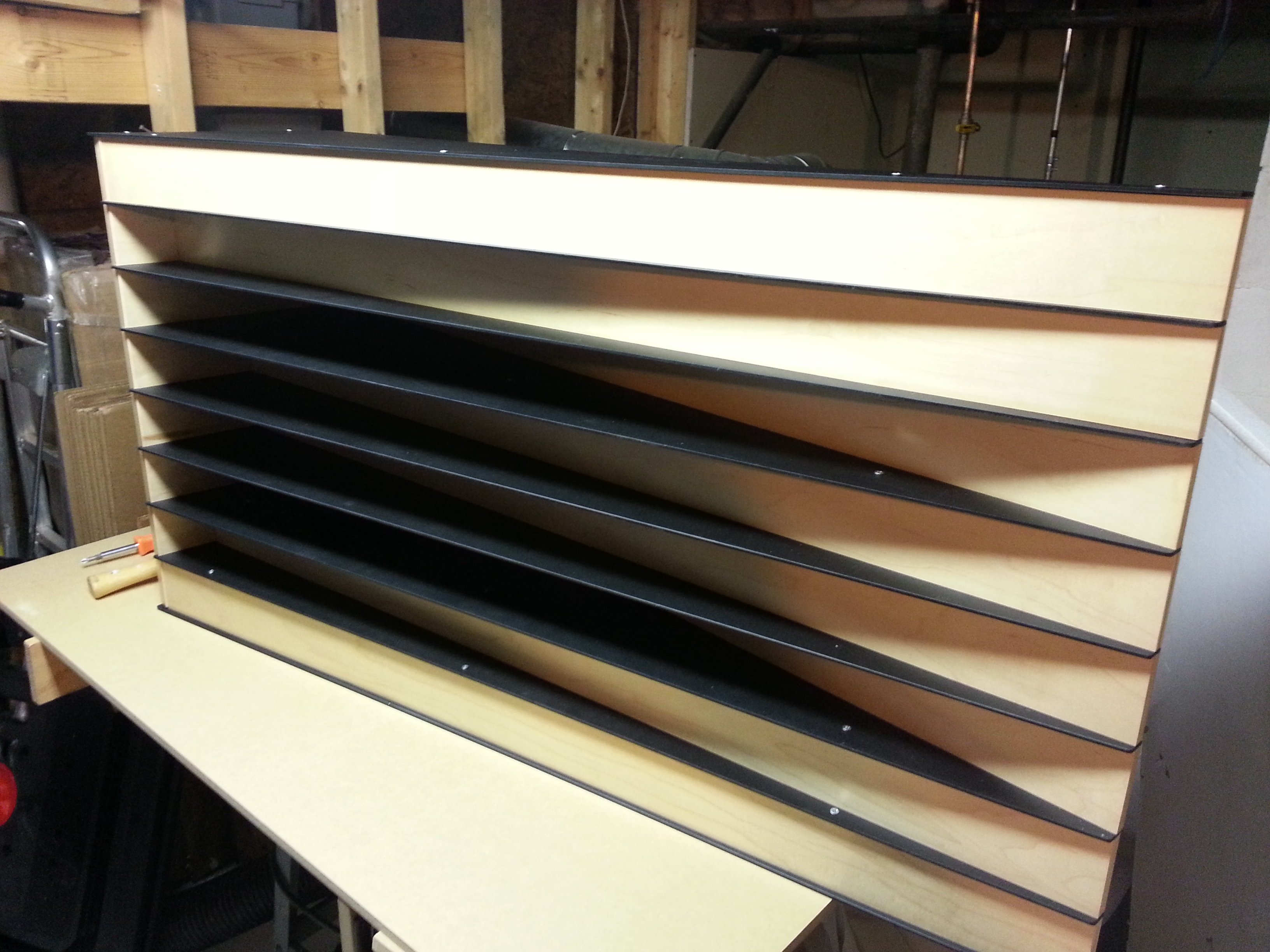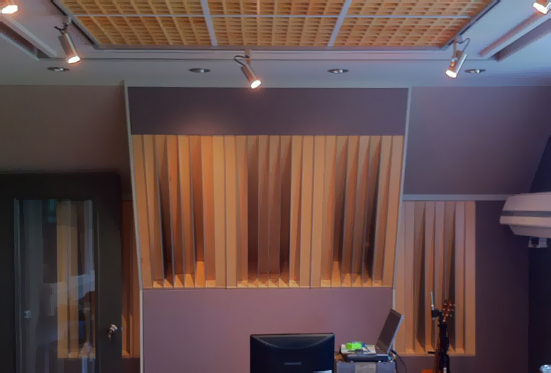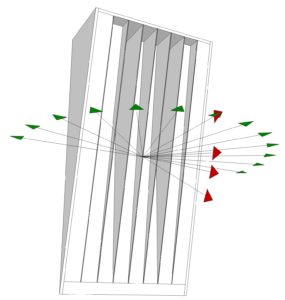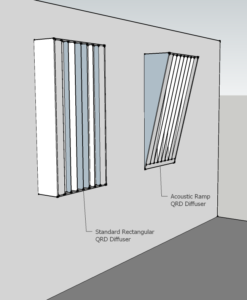A reflection of sound off of a flat hard surface can be disorienting and distracting. These reflections can mix with the source of the sound and cause comb-filtering, which changes the timbre (or tone color) of what you’re hearing. People often describe the effect of comb-filtering as “hollowing out” the sound, making the sound “tinny,” or making sound seem as though it is “in a garbage can.” Usually these are not the adjectives we want someone to use when describing our music!
The Acoustic Ramp is a wedge-shaped quadratic residue diffuser (QRD) that can tremendously mitigate undesirable acoustic effects like comb-filtering in a room without creating the deadening effects of overabsorption. By scattering sound reflections evenly across a range of angles, diffusers like the Acoustic Ramp can improve stereo imaging and spectral flatness by eliminating flutter echo, hard specular reflections, room modes and other problematic acoustic anomalies – but the Ramp does so with greater effectiveness than other popular diffuser designs.
The Ramp improves upon Manfred Schroeder’s technique for scattering sound, where periodic number sequences determine the ratios between the depths of adjacent reflective strips, or wells. The depths of these wells determine the frequencies at which a diffuser will be active; deeper wells allow for scattering at lower frequencies while shallower wells allow for scattering at higher frequencies. While other, simpler designs using Schroeder’s QRD equations use rectilinear wells of constant depth to scatter energy, the depths of the wells on the Acoustic Ramp vary continuously, greatly improving the effective bandwidth. Compare the frequency ranges at which the Ramp diffuses effectively to the same information for the RPG QRD 734, a popular diffuser:
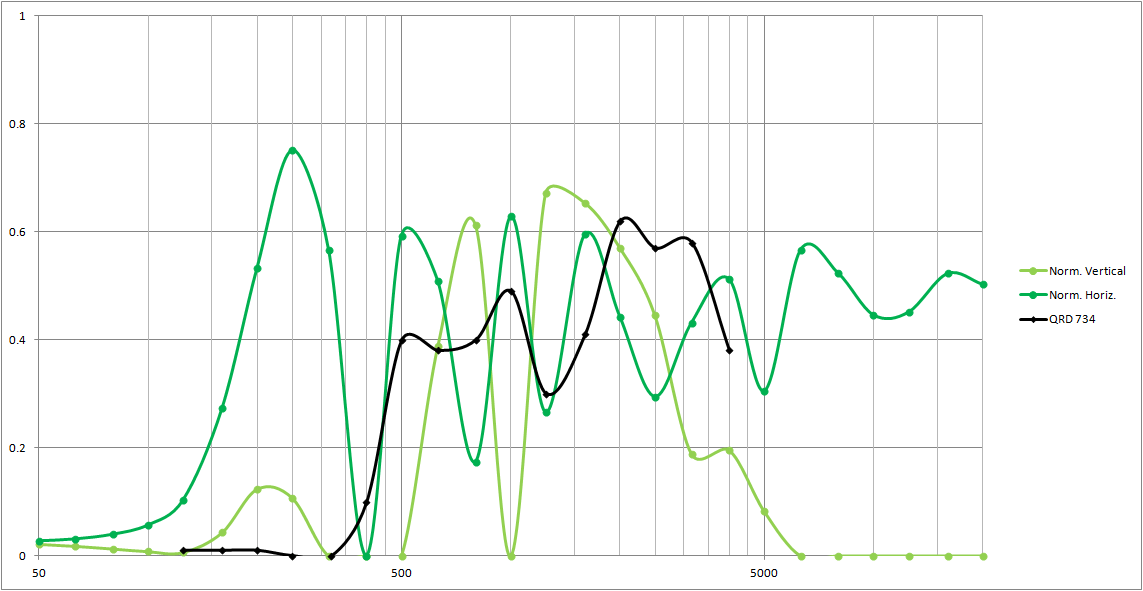
This graph also shows how, unlike rectilinear diffuser designs like that of the QRD 734, the angled reflectors and wedged shape of the Ramp scatter acoustic energy in both vertical and horizontal planes, evenly diffusing sound horizontally while reflecting energy over 4 different angles vertically.
All of these superior scattering properties combine with simpler implications of the Ramp’s design to create a diffuser that is more than the sum of its attributes. The wedged shape helps minimize parallel walls and direct reflections away from the sound source, while also allowing ease of movement and increased space for racks, furniture and other equipment that would not be possible with a rectilinear box of the same size. Compare the space demands of a standard rectilinear diffuser to those of the Ramp:
The Acoustic Ramp is available custom built to your exact specifications. The standard Ramp is constructed of 1/2′′ Rock Maple plywood reflectors, 1/8′′ black powder-coated aluminum dividers and a 3/4′′ Rock Maple plywood top plate, but custom ramps are available in almost any size configuration, with any choice of materials with any color powder coating.
Standard Ramp Specs:
Effective Diffusion Bandwidth: 300 Hz – 4 kHz
Effective Scattering Reflection Bandwidth: 300 Hz – 20 kHz
Quadratic Residue Sequence: Prime = 7
Height: 44 7/8′′
Width: 24′′
Depth: 12 1/4′′
Weight: 40 lbs.
Reflective Material: Furniture Grade 1/2′′ Pre-Finished Maple Plywood
Divider Material: Powder-coated 1/8′′ Aluminum Stock
Most Effective Installation Location: In critical listening rooms, an array of Acoustic Ramps make an ideal rear-wall treatment that helps to tighten the definition of imaging and clarifies the sound stage. In surround home theaters and group audiophile listening spaces, this rear-wall treatment helps to create a sense of envelopment and immersion for the listeners.
Testimonials:
“I assumed that the addition of two [Acoustic Ramp] diffusers to my control room’s comprehensive treatment package would lead to limited gains at best. In that regard, I was wrong. To put it succinctly, I was blown away by how much improvement I heard.”
–Andy Hong, Tape Op Gear Review Editor
“Placing [the ramp] on a stand directly behind mix positions improved bass response, removed edge from upper mids, and elongates highs so that reverb tails and quiet slaps become more apparent. It works as advertised and the change in sound from it being in place to it being removed is incredible. In my office, the biggest improvement was in the bass response. With it in place, my Tannoy Elipse 8 Actives really put out the 40hz they are rated for but when removed that enhancement was gone. There was also a lot more sizzle in the highs and the stereo field felt wider. In a lab the biggest improvement was in the midrange. There is always a murky, muddy quality to everything that you hear in there and ramp really opened it up.”
-Jonathan Sage, Audio Engineer, Boston College


